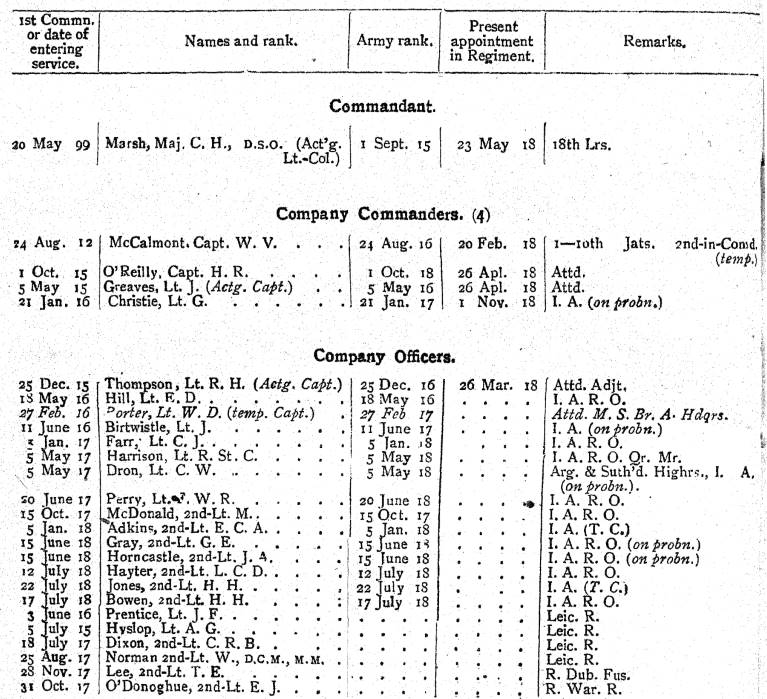This article is about the 2nd Battalion 10th Jats and will help you to research the Battalion and a soldier who served with it during the First World War. I have written a separate article about the 1st Battalion 10th Jats and a series of guides to help you to research an Indian soldier who served in the First World War:
The 2nd Battalion 10th Jats in the First World War
Lineage: The 2nd Battalion 10th Jats was formed at Jhansi (Uttar Pradesh, India) on 12 June 1917 and disbanded on 27 September 1921. For a history of the Regiment’s lineage see my page on the 1st Battalion 10th Jats.
Class Composition of Battalion in 1919: 4 Companies of Jats. The July 1918 edition of Indian Army List recorded that there was “1 special Company Bishnois, attached”. By the April 1919 edition, this company is no longer attached. July 1921: 2 Companies of Jats from the Punjab, 1 Company of Punjabi Musalmans and 1 Company of Musalman Rajputs.
The 2nd Battalion 10th Jats was a short-lived Indian infantry battalion formed at Jhansi (Uttar Pradesh, India) on 12 June 1917. Like the 1st Battalion 10th Jats, the 2nd Battalion was initially composed solely of Jats, though a special company of Bishnois was attached. When the Battalion was disbanded in 1921, Jats composed only half of its strength.
The Battalion’s first commanding officer was Lieutenant-Colonel Archibald Campbell Hobson, who was appointed from the 99th Deccan Infantry shortly after its formation. Lieutenant-Colonel Hobson commanded the Battalion until his death from enteric fever (typhoid) on 19 December 1917. Like other war raised units, the Battalion relied heavily on young and inexperienced British officers either Indian Army officers on probation or from the Indian Army Reserve of Officers. The extract below was taken from the July 1919 Indian Army List and recorded British officers serving with the Battalion.

Personnel– This regiment was not well supplied with regard to the nucleus received and this has been a continuous handicap. [Many war-raised 2nd battalions received a large draft of men from their 1st Battalion].
Fitness for active service– 586 men are fit for active service.
In the same report, Major-General Sir George Vere Kemball, Commanding 5th (Mhow) Division reported the following dated 6 April 1918:
The progress in training does not seem to have been maintained since I saw the battalion at the time of the death of Lieut-Colonel Hobson, the late Commanding Officer. The indifferent nucleus to this battalion has no doubt handicapped it. Officers unfavourably reported on are evidently weal points to be dealt with if satisfactory progress is not resumed.
Confidential review reports on Indian Army units, depots, British officers, etc. for 1917-1918: IOR/L/MIL/7/17029
The Battalion was inspected in February 1919 by Brigadier-General J. L. J. Clarke, Commanding 43rd Infantry Brigade:
General remarks– This battalion, though on 1 1/2 years old, had made satisfactory progress towards fighting efficiency. Training and Musketry handicapped by Influenza, Armistice and partial demobilization. Though not yet up to pre-war standard, promises to become so in the future.
Observations by Major-General Sir W. G. L. Beynon, Commanding 16th Indian Division – Great care in the training of recruits has resulted favourably on the general training of the battalion. It is not of course up to pre-war standard either as regards physique or training but is making great strides, and when the unfit and undesirables have been weeded out or demobilized, the appearance and training of the battalion will go ahead…
Confidential review reports on Indian Army units, depots, British officers, etc. for 1918-1919: IOR/L/MIL/7/17030
The Battalion served on the North West Frontier (Khyber Pakhtunkhwa, Pakistan) in 1919 and when it was inspected in 1920 was described as “A well run and well commanded Battalion” by Lieutenant-General Michael J. Tighe Commanding Poona Division. The Battalion served overseas, though its exact location is unclear. Two soldiers of the Battalion are commemorated on the Heliopolis (Port Tewfik) Memorial which indicates it served in Egypt or Palestine or both. The Battalion’s location was recorded as Delhi in the July 1921, Indian Army List and it was disbanded on 27 September 1921.
War Diaries of the 2nd Battalion 10th Jats
Unfortunately, there are no war diaries for the 2nd Battalion 10th Jats.
Further Sources of Information for the 2nd Battalion 10th Jats
Information regarding the British and Indian officers who served with the 2nd Battalion 10th Jats can be found by consulting the Indian Army List. Confidential reports for the Battalion are held at the British Library: Confidential Reports on Regiments etc. These reports also contain the annual reports of the British officers who served with the Battalion.
